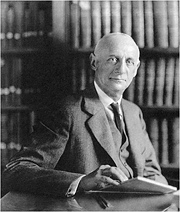The First Effective Therapy for Meningococcal Meningitis

Flexner, Simon
Courtesy of the Rockefeller Archive Center
In the winter of 1904-1905 meningococcal meningitis swept through New York City, killing more than 3,000 people as part of a worldwide pandemic. Simon Flexner (1863-1946), director of the newly established Rockefeller Institute for Medical Research, was appointed to a city health department commission to investigate the epidemic.
A renowned pathologist, Flexner knew that a bacterium caused the meningitis since it had been identified in 1887 and could be cultured easily. In addition, an antiserum that could kill the bacterium was available, made from the blood of horses infected with the it, but the therapy was being administered by subcutaneous injection and was not effective. Flexner also was familiar with cerebrospinal meningitis, having been part of a team that identified it during an epidemic among Maryland coal miners in 1893. From 1904 to 1907, he brought this field experience and his laboratory skills to bear on the disease. Using cultures from New York victims of the disease, he inoculated guinea pigs and monkeys to study the course of infection and ways of administering antiserum. He recognized that the problem was getting the antiserum where it was needed, in the brain, and thus he delivered it into the fluid that bathes the spinal column and the brain by a spinal (intrathecal) injection. The first human subjects received intrathecal injections of antiserum during a 1907 epidemic in Ohio. The death rate from the disease—which had been 75 percent—was cut in half. It remained the only effective therapy for three decades, until sulfa drugs and penicillin became available. The success of this treatment, which was widely reported in newspapers, impressed John D. Rockefeller, Sr. and helped persuade him to pledge funds, in 1908, to build the Rockefeller Hospital. By 1913, Flexner could report on the serum's effectiveness in treating 1300 patients around the world.

Flexner's laboratory at the Founder's Hall, 1908. Courtesy of the Rockefeller Archive Center
The therapy's success also depended on a potent antiserum, which was difficult to make. For several years scientists at the Rockefeller Institute prepared and distributed thousands of bottles of antiserum a year, free of charge. During World War I, outbreaks of meningitis in army barracks in Europe created a new demand for the antiserum. Scientists in Flexner's laboratory both developed a more efficient way to prepare the antiserum and, with support from the Rockefeller Foundation, distributed it during the war.
Simon Flexner received a medical degree from the University of Louisville in 1889. The next year he began a fellowship under William Henry Welch at the Johns Hopkins University, and early in 1893, he visited university laboratories in Europe. When the Johns Hopkins Medical School opened in 1893 Flexner was appointed to the faculty in pathology. He moved to the University of Pennsylvania in 1899, as professor of pathology. In 1901 Flexner was appointed to the Board of Directors of the newly formed Rockefeller Institute for Medical Research. He became the Institute's first director in 1902, remaining there until his retirement in 1935. In 1937 and 1938 he served as Eastman Professor at Oxford University. Among many awards and honors Flexner was elected to the American College of Physicians (1895) and the U.S. National Academy of Sciences (1908). Flexner's position at Rockefeller allowed him to become a leader in scientific publishing, in communicating about science to the public, and in guiding the development of graduate and postgraduate science education in the United States and abroad. His scientific contributions include the identification of Flexner's bacillus, a species of Shigella that causes tropical dysentery. With his son, James Thomas Flexner, he wrote a biography of his mentor: William Henry Welch and the Heroic Age of American Medicine (1942, 1993). Simon Flexner was the brother of Abraham Flexner, author of the 1910 "Flexner Report"—the most important work in reforming medical education in the history of the U.S.—and founder and first director of the Institute for Advanced Studies in Princeton, NJ.
Selected Publications
Flexner S. Contributions to the biology of Diplococcus intracellularis. J Exp Med, 1907, 9: 105-141
http://jem.rupress.org/cgi/reprint/9/2/105
Flexner S. Experimental cerebro-spinal meningitis in monkeys. J Exp Med, 1907, 9: 142-167.
http://jem.rupress.org/cgi/reprint/9/2/142
Flexner S. Concerning a serum-therapy for experimental infection with
Diplococcus intracellularis. J Exp Med, 1907, 9: 168-185
http://jem.rupress.org/cgi/reprint/9/2/168?
Flexner S and Jobling JW. Serum treatment of epidemic cerebro-spinal meningitis. J Exp Med, 1908, 10: 141-203
http://jem.rupress.org/cgi/reprint/9/2/168
Flexner S and Jobling JW. An analysis of four hundred cases of epidemic
meningitis treated with the anti-meningitis serum. J Exp Med, 1908, 10:
690-733
http://jem.rupress.org/cgi/reprint/10/5/690
Flexner S. The results of the serum treatment in thirteen hundred cases of epidemic meningitis. J Exp Med, 1913, 17: 553-576.
http://jem.rupress.org/cgi/reprint/17/5/553
Amoss HL and Wollstein M. A method for the rapid preparation of antimeningitis serum. J Exp Med, 1916, 23: 403-417
http://jem.rupress.org/cgi/reprint/23/3/403
Further Reading
Corner, GW. A History of the Rockefeller Institute, 1901-1953. (New York: Rockefeller Institute Press, 1964), 60-62
Corner GW. Flexner, Simon. In: Gillispie CC, ed. Dictionary of Scientific Biography. New York: Charles Scribner's Sons, 1970
Flexner JT. An American Saga: The Story of Helen Thomas and Simon Flexner. (Toronto: Little, Brown and Company, 1984)
Links
Simon Flexner Papers at the American Philosophical Society
http://www.amphilsoc.org/library/mole/f/flexner.htm
